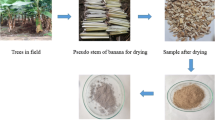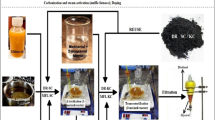Abstract
Esters of butanedioic acid (succinic acid) are appealing renewable esters as fuel additives and solvents. In the present study, we have investigated reaction routes for the esterification of succinic acid (SA) with alcohols like methanol (MeOH), ethanol (EtOH), and 2-propanol (2-PrOH) using heterogeneous catalyst D-Hβ (moderate Bronsted acidity) in a microwave (MW)-irradiated reactor to increase yield and minimize waste generation. Using the Box-Behnken design (BBD) approach, operating parameters such as reaction time, microwave power, and catalyst dosing were optimized for SA esterification with MeOH. At optimum conditions using D-Hβ catalyst, 99% maximum conversion was achieved with 98% selectivity of dimethyl succinate (DMS). At optimum conditions, the esterification of SA with EtOH and 2-PrOH was also performed. The use of D-Hβ is economically more advantageous as it can be reused directly without any prior washing and also showed significant activity.








Similar content being viewed by others
Data availability
Authors are agreed to, wherever possible and applicable, deposit data that support the findings of their research in a public repository.
Abbreviations
- MW:
-
Microwave
- SA:
-
Succinic acid
- DMS:
-
Dimethyl succinate
- DES:
-
Diethyl succinate
- D-n-PS:
-
Di-n-propyl succinate
- DIPS:
-
Diisopropyl succinate
- MWI:
-
Microwave irradiation
- GCMS:
-
Gas chromatography-mass spectroscopy
- SAN:
-
Succinic anhydride
References
Altuntepe E, Greinert T, Hartmann F et al (2017) Thermodynamics of enzyme-catalyzed esterifications: I. Succinic acid esterification with ethanol. Appl Microbiol Biotechnol 101:5973–5984. https://link.springer.com/article/10.1007%2Fs00253-017-8481-4
Bezerra MA, Santelli RE, Oliveira EP et al (2008) Review response surface methodology (RSM) as a tool for optimization in analytical chemistry. Talanta 76:965–977. https://doi.org/10.1016/j.talanta.2008.05.019
Brahmkhatri V, Patel A (2013) Esterification of bioplatform molecules over 12-tungstophosphoric acid anchored to MCM-41. J Porous Mater 20:209–217. https://doi.org/10.1007/s10934-012-9590-1
Budarin V, Luque R, Macquarrie DJ et al (2007a) Towards a bio-based industry: benign catalytic esterifications of succinic acid in the presence of water. Chem Eur J 13:6914–6919. https://doi.org/10.1002/chem.200700037
Budarin V, Clark J, Luque R et al (2007b) Versatile mesoporous carbonaceous materials for acid catalysis. Chem Commun: 634-636. https://doi.org/10.1039/B614537J
Camilo SL, Luuk AM, Wielen V et al (2014) Green upgrading of succinate using dimethyl carbonate for a better integration with fermentative production. Chem Eng J 235:52–60. https://doi.org/10.1016/j.cej.2013.09.017
Clark J, Budarin V, Dugmore T, Luque R, Macquarrie D (2008) Volodimir Strelko Catalytic performance of carbonaceous materials in the esterification of succinic acid. Catal Commun 9:1709–1714. https://doi.org/10.1016/j.catcom.2008.01.037
Corma A, Garcia H, Iborra S et al (1989) Modified faujasite zeolites as catalysts in organic reactions: esterification of carboxylic acids in the presence of HY zeolites. J Catal 120:78–87. https://doi.org/10.1016/0021-9517(89)90252-2
Desai KR (2004) Mechanism of microwave dielectric heating. Green Chemistry- Microwave Synthesis 1:12
Kappe CO (2004) Controlled microwave heating in modern organic synthesis. Angew Chem Int Ed 43:6250–6284. https://doi.org/10.1002/anie.200400655
Kolah A, Asthana N, Vu D et al (2008) Reaction kinetics for the heterogeneously catalyzed esTERIFICATION OF SUCCINIC ACID WITH ETHANOl. Ind Eng Chem Res 47:5313–5317. https://doi.org/10.1021/ie0706616
Khosravi M, Shinde (2014) S.N.Kinetic study of esterification of adipic acid with methanol over Amberlyst 15. Int J Chem Tech Res 6:4872–4877.https://sphinxsai.com/2014/ch_vol6_no11/5/(4872-4877)%20014.pdf
Le S, Nishimura S, Ebitani K (2019) Direct esterification of succinic acid with phenol using zeolite beta catalyst. Catal Commun 122:20–23. https://doi.org/10.1016/j.catcom.2019.01.006
Liu H, Peng Q, Ren J et al (2021) Synthesis of a sulfated-group-riched carbonaceous catalyst and its application in the esterification of succinic acid and fructose dehydration to form HMF. J Iran Chem Soc 18:2649–2656. https://doi.org/10.1007/s13738-021-02220-0
Lubsungneon J, Srisuno S, Rodtong S et al (2014) Nanofiltration coupled with vapor permeation-assisted esterification as an effective purification step for fermentation-derived succinic acid. J Membr Sci 459:132–142. https://doi.org/10.1016/j.memsci.2014.02.006
Matsumoto M, Tatsumi M (2018) Extraction and esterification of succinic acid using aqueous two-phase systems composed of ethanol and salts. 25:101–107. https://doi.org/10.15261/serdj.25.101
Nahrath S, Erkman S (2021) Carbon capture, utilization and storage in Switzerland volume 1 – the technological and scientific framework, Cahier de l'IDHEAP 315/2021,Unité Politiques publiques et durabilité Travail de mémoire Rapporteur IDHEAP, Lausanne ISBN 978–2–940667–05–5
Orjuela A, Kolah A, Lira CT et al (2011) Mixed succinic acid / acetic acid esterification with ethanol by reactive distillation Ind. Eng Chem Res 50:9209–9220. https://doi.org/10.1021/ie200133w
Orjuela A, Yanez AJ, Santhanakrishnan A et al (2012) Kinetics of mixed succinic acid/acetic acid esterification with Amberlyst 70 ion exchange resin as catalyst. Chem Eng J 188:98–107. https://doi.org/10.1016/j.cej.2012.01.10.3
Pambi RLL, Musonge P (2016) Application of response surface methodology (RSM) in the treatment of final effluent from the sugar industry using Chitosan. WIT Transactions on Ecology and The Environment. Vol 209,WIT Press. https://doi.org/10.2495/WP160191
Parmar JA, Gandhi DR, Chopda LV et al (2021) Esterification of bioplatform molecule succinic acid using ZSM-5 and HZSM-5 catalysts 63: 75–83, https://doi.org/10.1080/00194506.2019.1699872
Umrigar V, Chakraborty M, Parikh PA (2018) Catalytic activity of zeolite Hβ for the preparation of fuels’ additives: its product distribution and scale up calculation for the biofuel formation in a microwave assisted batch reactor. J Environ Chem Eng 6:6816–6827. https://doi.org/10.1016/j.jece.2018.10.059
Verma RS, Namboodiri VV (2001) Solvent-free preparation of ionic liquids using a household microwave oven. Pure Appl Chem 73:1309–1313. https://doi.org/10.1351/pac200173081309
Williamson KL (1994) Synthesis of esters by Fisher esterification, macroscale and microscale organic experiments, 2nd Ed., Houghton Mifflin, Boston, 385. https://support.minitab.com/en-us/minitab/18/help-and-how-to/modeling-statistics/doe/how-to/response-surface/analyze-response-surface-design/interpret-the-results/all-statistics-and-graphs/model-summary-table/
Acknowledgements
We are thankful to the Department of Chemical Engineering, SCET, and SVNIT for the project work. We are grateful to the Sophisticated Analytical Instrument Facility (SAIF) IIT-Bombay for the GCMS analysis.
Author information
Authors and Affiliations
Contributions
All authors whose names appear on the submission.
1. Dr. Vaishali Umrigar made substantial contributions to the conception or design of the work; or the acquisition, analysis, or interpretation of data; or the use of software in the work;
2. Dr. Vaishali Umrigar and Prof. Mousumi Chakraborty drafted the work or revised it critically for important intellectual content;
3. Prof. Chakraborty and Prof. Parikh approved the version to be published; and.
4. All agreed to be accountable for all aspects of the work in ensuring that questions related to the accuracy or integrity of any part of the work are appropriately investigated and resolved.
Corresponding author
Ethics declarations
Ethics approval
• The manuscript is not submitted to more than one journal for simultaneous consideration.
• The submitted work is original and should not have been published elsewhere in any form or language (partially or in full).
• A single study has not been split up.
• Results are presented clearly, honestly, and without fabrication, falsification, or inappropriate data manipulation (including image-based manipulation). Authors adhere to discipline-specific rules for acquiring, selecting, and processing data.
• No data, text, or theories by others are presented as if they were the author’s own (“plagiarism”). Proper acknowledgments to other works are given.
• We are thankful to the Department of Chemical Engineering, SCET, and SVNIT for the project work. We are grateful to the Sophisticated Analytical Instrument Facility (SAIF) IIT-Bombay for the GCMS analysis.
Consent to participate
This presentation is submitted with respect to the author’s virtual participation in the 2nd IC2S2TD-2021 and invitation to publish this work as a special issue in Environmental Science and Pollution Research as “SI: CSSTD-2021.”
Consent for publication
All authors agreed with the content and that all gave explicit consent to submit and that they obtained consent from the responsible authorities at the institute/organization where the work has been carried out before the work is submitted.
Competing interests
Interests related to the submitted work are as follows.
1. Further operating parameters can be optimized with different design and optimization tools to avoid trial and error.
2. Scale-up can be done for further implementation of the production of such biofuel’s additives to commercialize the products.
3. Extraction of carboxylic acids from natural resources can be further worked out.
Additional information
Responsible Editor: Philippe Garrigues
Publisher's note
Springer Nature remains neutral with regard to jurisdictional claims in published maps and institutional affiliations.
Rights and permissions
Springer Nature or its licensor holds exclusive rights to this article under a publishing agreement with the author(s) or other rightsholder(s); author self-archiving of the accepted manuscript version of this article is solely governed by the terms of such publishing agreement and applicable law.
About this article
Cite this article
Umrigar, V., Chakraborty, M. & Parikh, P.A. Optimization of microwave-assisted esterification of succinic acid using Box-Behnken design approach. Environ Sci Pollut Res 30, 71472–71481 (2023). https://doi.org/10.1007/s11356-022-22807-1
Received:
Accepted:
Published:
Issue Date:
DOI: https://doi.org/10.1007/s11356-022-22807-1




